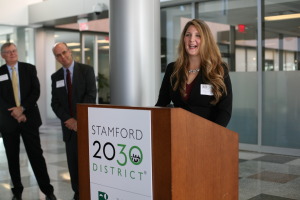When it comes to storm resiliency and energy efficiency, Stamford is one of six cities nationwide eager to pick up a scorecard and mark its progress ”“ not based on the number of electric vehicles on the road but by the eco-friendliness of commercial building projects.
The city at a recent ceremony announced its involvement with Architecture 2030, a nonprofit research organization that focuses on investing in the sustainability of commercial buildings from design to construction. Calling it the Stamford 2030 District, an iteration of Architecture 2030, the initiative is spearheaded by Stamford business leaders, property owners and managers and community and professional partners, including the city of Stamford, The Business Council of Fairfield County, the Connecticut Fund for the Environment, First County Bank and Reckson, a division of SL Green Realty Corp.
The idea is to make Stamford more resilient in the face of climate change and encourage stakeholders to share best practices in architectural design, construction and technology, with a goal of reducing energy and water use and carbon emissions by at least 10 percent by 2030.

“The 2030 District will help us meet our national and state goals of emission reduction,” said Megan Saunders, executive director of the Stamford 2030 District. “Over the next few months, we”™ll be benchmarking our buildings for energy and water use and comparing them to national standards. We”™ll be forming a board and looking for leaders to help join in the district. We”™ll be looking at new technologies, innovative solutions and funding mechanisms to help us meet our goals.”
Through energy efficiency projects, large businesses can save $1.3 million annually with a payback of less than three years, said Jay Black, director of sustainability at SL Green.
The Connecticut Fund for the Environment and The Business Council of Fairfield County began working with corporate leaders and experts in energy-efficient architectural design last year to explore whether Stamford had the potential to become a 2030 District. After examining the city”™s old infrastructures and their vulnerabilities to climate change and rising sea levels, these organizations identified the importance of reinvesting in the city”™s commercial and multifamily housing stock.
Stamford”™s downtown has become a burgeoning hot spot for economic development projects, further attracting young professionals and businesses to the city. Thomas Madden, Stamford”™s economic development director, said the trend in urban settings is that people care about living and working in eco-friendly environments.
“There are lots of millennials working in downtown Stamford, and if I”™m a millennial working for you, I want to make sure my company is putting its best foot forward to be energy efficient,” Madden said. “You also get a much better building you want to live in, and it lowers rent because you”™re not spending money on the overall infrastructure. So your water, electrical bills start going down, and it makes rent much more competitive.”
Rey Giallongo, First County Bank CEO and chairman of the bank”™s board, said he sees value in being a member of the Stamford 2030 District. To him, improving the quality of real estate means his properties will be more attractive for potential tenants.
“Our ability to improve our commercial real estate stock will help us compete with New York and our Connecticut neighbors for the next commercial real estate tenants,” Giallongo said. “The cost-per-square-foot equation when you”™re signing a lease is an important question to ask potential landlords. But I also know that asking your landlord about energy efficiency and environmental questions come up very frequently.”
Chris Bruhl, president and CEO of The Business Council of Fairfield County, said the 23 companies that are involved in the Stamford 2030 District and supporting green practices for commercial buildings want to be leaders in the industry on a national and global scale.
The other five cities that have set up 2030 Districts are Cleveland, Denver, Los Angeles, Pittsburgh and Seattle. Stamford is the first in New England to establish a district.
The founding members of the Stamford 2030 District include 12 property managers: The Ashforth Co., Aquarion Water Co., CBRE, Charter Oak Communities, the city of Stamford, the Ferguson Library, First County Bank, Jones Lang LaSalle, New Neighborhoods Inc., Reckson, Jonathan Rose Cos. and the Unitarian Universalist Congregations. The five community partners are The Business Council of Fairfield County, the Connecticut Fund for the Environment, Connecticut”™s Green Bank/CEFIA, the Connecticut Chapter of the American Institute of Architects, and Downtown and Sustainable America. The three business partners are Connecticut Light & Power, Starwood Hotels and Resorts Worldwide and Steven Winter Associates Inc.



















Comments 2